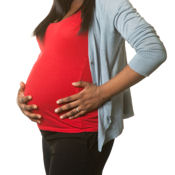 Buses and trains tend to have narrow aisles and cramped bathrooms; however, both modes of transportation are safe during your pregnancy. Some things to consider when traveling by bus or train:
Buses and trains tend to have narrow aisles and cramped bathrooms; however, both modes of transportation are safe during your pregnancy. Some things to consider when traveling by bus or train:
- Be sure to hold on to the seat backs when walking up and down the aisles.
- These may not be the best modes of transportation if you are experiencing any pregnancy sickness.
- Avoid train cars or buses that permit smoking.
- Move and stretch every few hours to prevent blood clots.
- Drink plenty of water to diminish motion sickness.
Traveling by Airplane
If you are planning to travel by air, keep in mind that USA domestic airline regulations prohibit air travel in the last four weeks of your pregnancy (36+ weeks pregnant). Foreign airlines prohibit air travel after 35 weeks. If you look pregnant, airlines require a note from your healthcare provider stating your estimated date of delivery.
When you are booking your flight keep these things in mind:
- Avoid all flights where smoking is allowed. While smoking is not permitted on USA domestic flights, some foreign carriers still permit smoking. Even though aircrafts are divided into smoking and non-smoking sections, trying to keep the air in a smoking section is like trying to chlorinate half a swimming pool.
- Be sure your plane has a pressurized cabin. Be especially careful with commuter flights, as they are not pressurized, since they usually fly at low altitudes. While a short time spent in an un-pressurized cabin above 7,000 feet is unlikely to harm your baby (baby's oxygen level in the womb is already lower than mother's), it can reduce the oxygen in your blood, causing you to feel lightheaded and impair your thinking and ability to move.
- Request a seat as far forward on the aircraft as possible. Not only is the air circulation better in front, it's easier to get on and off the aircraft. Some women find a window seat helpful for minimizing early-pregnancy queasiness; others prefer an aisle seat, which makes it easier to walk and go to the bathroom. If you are traveling with a companion, request the aisle and window seat, and ask that the middle seat be left vacant to give you some extra space for maneuvering unless the space is needed.
- Consider requesting a bulkhead seat if you need additional leg room. Note that the armrests are stationary, which can restrict your sideways mobility and prevent you from stretching out, should the adjacent seat be vacant.
- If morning sickness is a problem, try to arrange travel during a time of day when you generally feel well. Seats over the wing in the midplane region will provide the smoothest ride.
- Calling ahead to request a special meal can increase your chance of getting the airline food most friendly to your stomach. Better yet, pack your own meal. Alert the flight attendant of any special needs.
More considerations as you prepare to travel by plane:
Continued ›
|
 Buses and trains tend to have narrow aisles and cramped bathrooms; however, both modes of transportation are safe during your pregnancy. Some things to consider when traveling by bus or train:
Buses and trains tend to have narrow aisles and cramped bathrooms; however, both modes of transportation are safe during your pregnancy. Some things to consider when traveling by bus or train: 





Member Comments